I recently received an email from Jessica Okazaki, from the Richard Stockton College of New Jersey, asking about Middlebury’s no-mow program. She is interested in starting a similar project at her school. Read more at her Facebook group called “Lose the Lawn”. I’m sure she isn’t the only one thinking about this on a college campus, so I thought that rather than just responding to her alone I would turn the answers into a blog post. A couple of her questions are below.
For my project, I am hoping to plant native plants to this pinelands region, (or even better -native endangered/threatened species if they can grow on this soil). In some areas, I think I would like native grass, similar to lawn but needs no mowing… so that the students can walk on them without killing the plants… if that’s possible…..
I would like your tips / advice on how to prepare the right soil for native plants and some specific plants you might recommend.
I’ll speak first about the sites you have in mind, and keep in mind I’m looking at this from 300+ miles away, and don’t know much about the Pine Barrens. Your master plan is an excellent document, and has some great insights into your landscape in general.
Middlebury College and Richard Stockton seem to have drastically different landscapes, not only ecologically but from a human standpoint as well. Your beautiful campus is considerably more condensed, surrounded by woods (at least according to Google Maps). Here at Middlebury we have a relatively large but spread out campus. Many of our no-mow zones are many acres in size, while some of the areas you have in mind look quite a bit smaller.
Our no-mow zones are simply that-areas where we have let the lawn go. Native and non-native wildflowers are infiltrating the areas, and we are achieving a nice effect of contrast between mown lawn and no-mow, helping to differentiate sections of our campus. Because of their size, we couldn’t possibly think about re-landscaping these areas with plants, or even reseeding. It would be nice to plant these areas in Meadow plants, but the labor and herbicide needed on this scale would be far too costly. Your campus, though, seems to have many little pockets of lawn that aren’t needed, and these certainly can be re-done in native grasses and wildflowers. I think, though, that I wouldn’t try to find native grass that can be walked upon by students, but think in terms of taking entire areas out of circulation completely, and leaving the trafficked areas in lawn.
The problem is the amount of traffic in small areas, especially on college campuses. We affectionately refer to these as “goat paths”. No plant can take a constant traveled lane like this, particularly fussy native wildflowers. Focus on a healthy lawn in these areas.
In terms of preparing the soil for your project, there is no way for me to give any specific recommendations from here. A soil test would be a crucial first step before anything happens. I do have some general advice, though. Based on many of your pictures posted on the Facebook group, your campus suffers from the same general problem as ours, that of soil compaction. I see in many of the rainy day pictures standing water in the lawn, and you mention that it is the lawn not able to absorb the rainfall. Truthfully, it isn’t the lawn absorbing rain, but the soil. A hard, compacted topsoil cannot soak in a rainfall, and water does tend to run off. The best cure to relieve compaction is to eliminate the stress (probably foot traffic, lawn mowers, etc.), and to add organic matter, such as compost. Aeration would certainly help as well. Rain gardens can be used where water concentrates.
Here’s a photo of a nice pine stand. No lawn underneath, but who cares? This is probably because of the soil and shade from the pines. There probably are wildflowers that would grow in an area like this, but not many. Dry shade can be tricky.
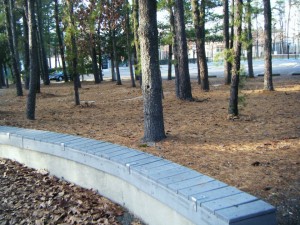
Here’s the same area (I think, remember I’m 350 miles away), after a hard rain. This screams compaction, possibly from foot traffic heading toward the parking lot? Or was this just a heck of a rain storm?

In terms of other soil amendments, I constantly remind myself that I can’t fight geology-you have to play the cards you are dealt. If your soil conditions are radically different compared to the plants you would like, you probably aren’t looking at the right types of plants. Lists abound of native plants and certain well-behaved non-natives appropriate for all types of soil and landscape conditions .When amending soil one really needs to amend an entire bed, not just planting holes, and these can get costly in large areas. Certainly minor adjustments, such as fixing a nitrogen deficiency aren’t terribly difficult. In general, and listen for many other horticulturists gasping in pain as they disagree, wildflowers don’t need super rich soil to thrive, certainly not like our coddled landscape plants of today.
This is the area mentioned on the Facebook group as the first area to plant. I see evidence of compaction here too.
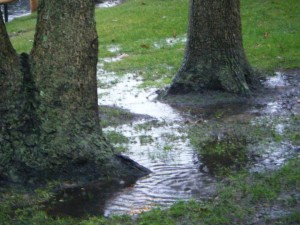
If I’m reading the maps and your description correctly, I like the area you’ve chosen to trial. Establishing a new bed can be difficult, and it is nice to have it surrounded by buildings/parking lots. I always think of weed infiltration-if the area you want to plant is surrounded by lawn, the seeds from those grasses and lawn weeds can blow in and make the new bed harder to maintain, as the weeds need to be removed frequently in the first couple of years to avoid the competition.(They’re called weeds for a reason!)
Another thought is to work closely with the Grounds department. One of the best parts of our no-mow program was the reduction in labor from constant mowing. We’ll be honest-some of our no-mow areas were picked because we didn’t really want to mow them (!). Some small no-mow areas you may like to plant may take 3 times as long to mow as other areas because of obstructions such as trees and planted beds. You can get a larger bang for your environmental buck by removing these slow to mow zones.
Here’s a picture from the Facebook group of an area you think should not be lawn.
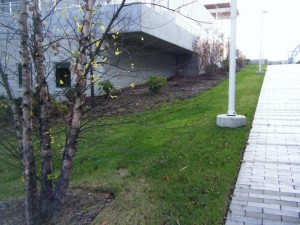
To me, extending the bed from the building would add a tremendous amount of weeding that would have to be done, although it is hard to get the right context where this is on campus based on this picture. If the bed were eliminated and the entire area planted in natives the strip would still need to be mown next to the walk (tick control), leaving an awkward area in between that strip and the building.
This is a good area for no-mow-
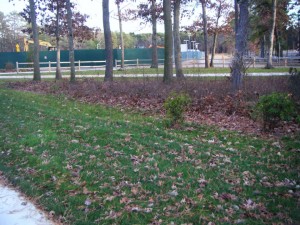
Extending this existing bed/wild area under the trees would lose quite a bit of lawn, and look in the landscape like a logical extension of the area.
Lose the lawn here too-
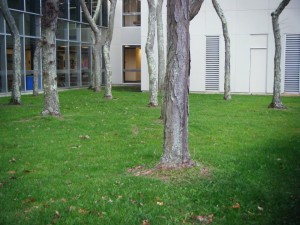
This area looks unused, with no doors or pathways evidenced. It also looks hard to mow, with a lot of weedwacking. A native stand of plants under the trees would look quite attractive. The trees do seem to be planted in a grid, was this supposed to be (or is) an outdoor recreation area?
Your last question, that of specific plants, I’m afraid I’ll be no use. New Jersey is a world away ecologically compared to the Champlain Valley. A little bit of googling while eating my lunch led me toward some interesting sites-like the Plants of Southern New Jersey, and some interesting work on Native Warm Season Grass Meadows, including an interesting PDF here from the New Jersey NRCS. I liked Professor Jack Conner’s blog.
I wish you the best of luck. Let us know how it goes.
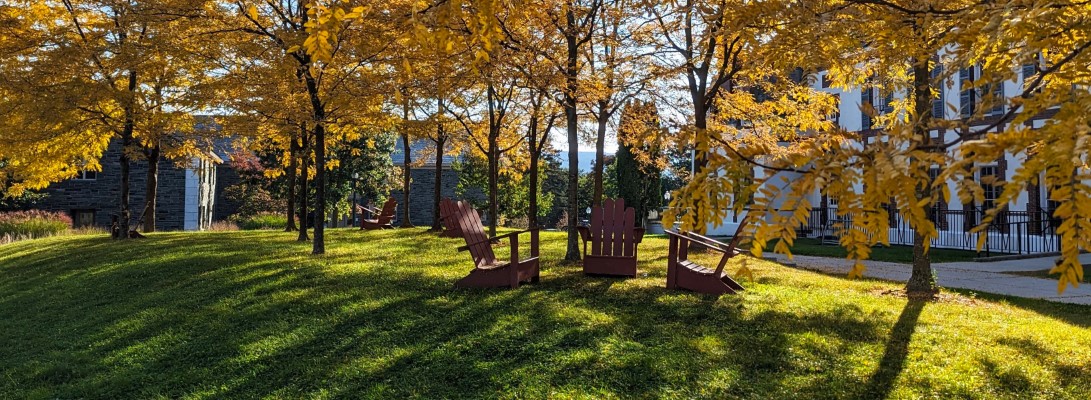
One thought on “No-Mow at Richard Stockton”